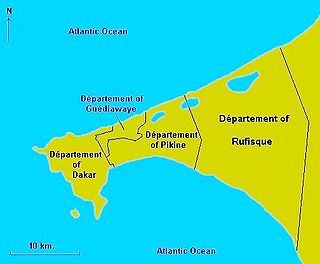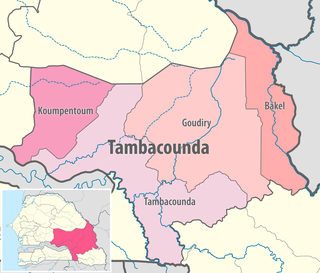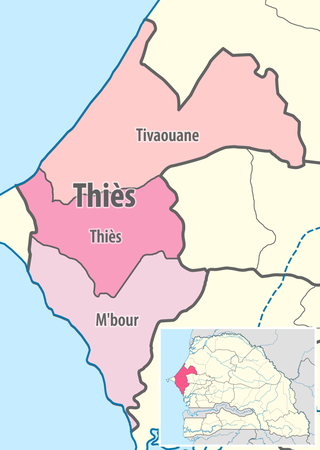
Dakar region is the smallest and most populated region of Senegal, encompassing the capital city of the country, Dakar, and all its suburbs along the Cap Vert peninsula, Africa's most westerly point.

The 14 regions of Senegal are subdivided into 46 departments and 103 arrondissements and by collectivités locales which elect administrative officers.
Senegal is subdivided into four levels of administrative divisions.

Pikine is a city in the Pikine Department of the Dakar Region of Senegal. Lying to the east of Dakar city centre, at the 2013 Census it had a population of 1,170,791. The department includes the villages of Yeumbeul, Thiaroye, Mbao, and Keur Massar Malika. Until the mid-2000s, it also included Guédiawaye, which now forms a separate Department.

Guédiawaye is a city in the Guédiawaye Department of the Dakar Region of Senegal. Lying on the Atlantic Ocean to the northeast of Dakar city centre, in 2013 it had a population of 329,659. Until the mid-2000s, the département was part of Pikine.

The departments of Senegal are subdivided into arrondissements. As of 2008 there were 133. The arrondissements are listed below, by department:

Diourbel department is one of the 46 departments of Senegal, one of the three constituting the Diourbel region.

Bakel department is one of the 46 departments of Senegal and one of the four making up the Tambacounda region in the east of the country. The department had an area of 22,378 km² and population estimate at 215,680 in 2005. However, in 2008 the department was split to form the new department of Goudiry, so the area was reduced to estimated 6,290 km².

Tambacounda department is one of the 46 departments of Senegal, and one of the four making up the Tambacounda region. It formerly covered an area of 20,328 km² and in 2013 had an estimated population of 283,769. However in 2005 it was reduced in size to create the new Koumpentoum department.

Kolda department is one of the 46 departments of Senegal, located in the Kolda region in the centre of the country.

Fatick department is one of the 46 departments of Senegal, one of the three departments making up the Fatick region, and lies on the road between Mbour and Kaolack. The Fatick region is home to many Sereer people ; the Sereers are one of the major ethnic groups in Senegal and there are four Sereer dialects. At least 99% of the regional area consists Seereer, notably of Seereer Niominka people, and less than 1% of migrant Fulbe.

Rufisque department is one of the 46 departments of Senegal and one of the four which make up the Dakar region.

M'bour department is one of the 46 departments of Senegal, one of three in the Thiès region. Its capital is M'Bour.

Thiès department is one of the 46 departments of Senegal, one of the three located in the Thiès region.

Tivaouane department is one of the 46 departments of Senegal, and one of the three in the Thiès region. Its capital is Tivaouane.

Thiaroye is the name of a historic town in Sénégal, situated in the suburbs of Dakar, on the southeast coast of the Cap-Vert peninsula, between Pikine and Rufisque.
Dagoudane Arrondissement is an arrondissement of the Pikine Department in the Dakar Region of Senegal.
Niayes Arrondissement is an arrondissement of the Pikine Department in the Dakar Region of Senegal.
Thiaroye Arrondissement is an arrondissement of the Pikine Department in the Dakar Region of Senegal. The seat lies at Thiaroye.
Matador is one of the most prominent figures of underground Hip Hop in Senegal. Founding member of the Thiaroye’s group, WA BMG 44, Matador has toured throughout the world gaining an international recognition from the underground hip hop scenes abroad. Since 2006, his struggle to represent the voiceless youth of his home country has taken a renewed turn with the creation of his structure, Africulturban in Pikine. Through this space dedicated to the youth, Matador reiterates his social and political engagement while pursuing his role of “Number One System Enemy” and “General Major Chief of the Dying People Army”.














